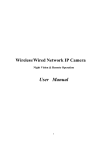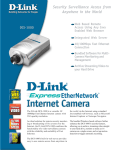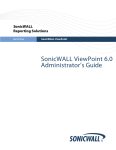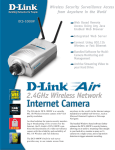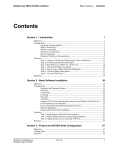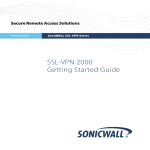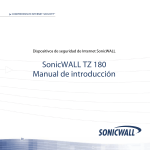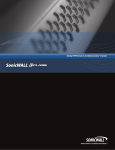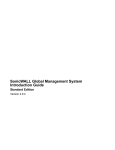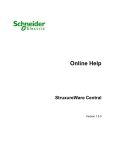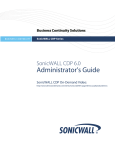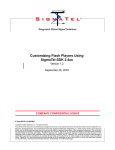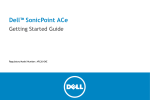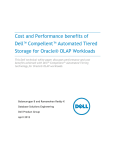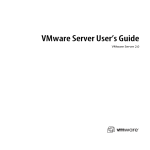Download SonicWALL ViewPoint Virtual Appliance Getting Started Guide
Transcript
ViewPoint Virtual Appliance 6.0 Getting Started Guide PROTECTION AT THE SPEED OF BUSINESS™ SonicWALL ViewPoint Virtual Appliance 6.0 Getting Started Guide This Getting Started Guide contains installation procedures and configuration guidelines for deploying the SonicWALL ViewPoint Virtual Appliance on a server on your network. The SonicWALL ViewPoint Virtual Appliance is a virtual machine that runs SonicWALL ViewPoint, which is a Web-based application that can generate dynamic real-time and historical reports for a complete view of all activity through SonicWALL network security appliances. The SonicWALL ViewPoint Virtual Appliance provides the following benefits: • Cost savings: • Multiple virtual machines can run on a single server, reducing hardware costs, power consumption, and maintenance costs. • Microsoft Windows OS is not required, eliminating the cost of the Windows licensing. • Operational ease: • In a virtual environment, it is easy to commission new servers or decommission old ones, or to bring servers up or down. • Installation is accomplished by importing a file into the virtual environment, with no need to run an installer. • Easy reallocation of resources: • In a virtual environment, you can easily relocate virtual machines to a datastore with more free hard disk space. • On a physical server, you must open up the hardware to install more resources. • Security: • SonicWALL ViewPoint Virtual Appliance provides the same hardened operating system that comes with the SonicWALL UMA EM5000 appliance. Note: For SonicWALL ViewPoint documentation, refer to the SonicWALL ViewPoint 6.0 Administrator’s Guide. This and other documentation are available at: http://www.sonicwall.com/us/Support.html SonicWALL ViewPoint Virtual Appliance 6.0 Getting Started Guide Page 1 Contents This document contains the following sections: Page 2 1 “Before You Begin” on page 3 • “Supported Platforms” on page 3 • “Hardware Resource Requirements” on page 3 • “Files for Installation” on page 4 2 “Installing SonicWALL ViewPoint Virtual Appliance” on page 6 • “About Thick and Thin Provisioning” on page 7 • “Installing with vSphere” on page 7 • “Installing with vCenter Converter Standalone” on page 14 3 “Performing Basic Tasks and Host Configuration” on page 20 • “Powering the Virtual Appliance On or Off” on page 22 • “Configuring Host Settings on the Console” on page 22 • “Configuring Host Settings on the Appliance Web Interface” on page 24 4 “Registering and Licensing SonicWALL ViewPoint” on page 28 • “Creating a MySonicWALL Account” on page 28 • “Registering / Licensing the SonicWALL ViewPoint Virtual Appliance” on page 29 5 “Configuring the Deployment Role” on page 31 • “Configuring Deployment Settings” on page 32 6 “Introduction to the Management Interfaces” on page 35 • “Overview of the Two Interfaces” on page 35 • “Switching Between Management Interfaces” on page 36 7 “Next Steps” on page 37 8 “Updating the SonicWALL ViewPoint Virtual Appliance” on page 38 1 Before You Begin This section contains the following subsections: • “Supported Platforms” on page 3 • “Hardware Resource Requirements” on page 3 • “Files for Installation” on page 4 Supported Platforms The elements of basic VMware structure must be implemented prior to deploying the SonicWALL ViewPoint Virtual Appliance. SonicWALL ViewPoint Virtual Appliance runs on the following VMware platforms: • ESXi 4.0 Update 1 (Build 208167 and newer) • ESX 4.0 Update 1 (Build 208167 and newer) You can use the following client applications to import the image and configure the virtual settings: • VMware vSphere – Provides infrastructure and application services in a graphical user interface for ESX/ESXi, included with ESX/ESXi. Provides Thick provisioning when deploying SonicWALL ViewPoint Virtual Appliance. • VMware vCenter Converter Standalone – Free software that allows you to specify Thin or Thick (Flat) provisioning for your SonicWALL ViewPoint Virtual Appliance deployment. Available for download at: https://www.vmware.com/products/converter/ • VMware vCenter Server – Centrally manages multiple VMware ESX/ESXi environments. Provides Thick provisioning when deploying SonicWALL ViewPoint Virtual Appliance. Hardware Resource Requirements The following hardware resources are required for SonicWALL ViewPoint Virtual Appliance: • RAM – 3168 MB This is the maximum amount of RAM supported by the SonicWALL ViewPoint Virtual Appliance operating system, SonicLinux (VM), which is a 32-bit OS. Additional RAM provided to SonicWALL ViewPoint Virtual Appliance in the virtual environment will not be utilized. A smaller amount of RAM can be configured, but is not recommended. • CPU – 2 This is the default number of CPUs provisioned in the SonicWALL ViewPoint Virtual Appliance. The minimum required number of CPUs is 1, and the maximum that the SonicWALL ViewPoint Virtual Appliance can use is 4. SonicWALL ViewPoint Virtual Appliance 6.0 Getting Started Guide Page 3 • Hard disk space: • For the 250 GB image – Up to 250 GB on any datastore • For the 950 GB image – Up to 950 GB on a datastore with either a 4 MB or 8 MB block size When using Thick, or Flat, provisioning as the storage type option, the entire amount of disk space is allocated when you import and deploy the SonicWALL ViewPoint Virtual Appliance file. When using Thin provisioning, the initial size is approximately 20 GB and will grow dynamically as more disk space is needed by the SonicWALL ViewPoint application, until the maximum size is reached. Once allocated, the size will not shrink if the application space requirements are subsequently reduced. Additional disk space provided to SonicWALL ViewPoint Virtual Appliance in the virtual environment, beyond the respective limits of 250 GB or 950 GB, will not be utilized. ESX/ESXi can be configured with datastores of varying block sizes. The 4 or 8 MB requirement for the 950 GB deployment is because the block size determines the largest virtual disk that can be deployed, as shown in the table: Table 1: Block Size Effect on Virtual Disk Size Block Size of Datastore Largest Virtual Disk 1 MB 256 GB 2 MB 512 GB 4 MB 1 TB 8 MB 2 TB Files for Installation You will use different files for a fresh installation than when updating to a newer version. Fresh Installation Files SonicWALL ViewPoint Virtual Appliance is available for download from MySonicWALL. For a fresh install, two Open Virtual Appliance (OVA) files with the following file name format are available for import and deployment to your ESX/ESXi server: • sw_gmsvp_vm_eng_6.0.xxxx.yyyy.250GB.ova • sw_gmsvp_vm_eng_6.0.xxxx.yyyy.950GB.ova The 250 or 950 in these file names indicates the maximum size of the deployed virtual appliance in gigabytes. The xxxx.yyyy represents the actual build number. Note: Do not rename the OVA files. Page 4 Updater File For a software update, a file with the following file name format is available from MySonicWALL: • sw_gmsvp_vm_eng_6.0.xxxx.yyyy.gmsvp-updater.sh Note: Do not rename the updater file. The sw_gmsvp_vm_eng_6.0.xxxx.yyyy.gmsvp-updater.sh file is uploaded to the System > Settings page on the appliance management interface of your existing SonicWALL ViewPoint deployment. Patch and Hot Fix Files All service packs for patches and hot fixes are identical for SonicWALL ViewPoint deployments on Windows and SonicWALL ViewPoint Virtual Appliance. SonicWALL ViewPoint Virtual Appliance 6.0 Getting Started Guide Page 5 2 Installing SonicWALL ViewPoint Virtual Appliance SonicWALL ViewPoint Virtual Appliance is installed by deploying an OVA file to your ESX/ESXi server. Each OVA file contains all software components related to SonicWALL ViewPoint including the MySQL database, executable binary files for all ViewPoint services, and other necessary files. You can deploy either of the OVA files as needed for your SonicWALL ViewPoint environment. You can deploy an OVA file by using the vSphere client, which comes with ESX/ESXi, or by using the free VMware vCenter Converter Standalone tool. For vSphere, point a browser to your ESX/ESXi server and click on Download vSphere Client. To use VMware vCenter Converter Standalone, you can download it at: https://www.vmware.com/products/converter/ Page 6 See the following sections: • “About Thick and Thin Provisioning” on page 7 • “Installing with vSphere” on page 7 • “Installing with vCenter Converter Standalone” on page 14 About Thick and Thin Provisioning You can specify Thick or Thin provisioning when an OVA file is deployed on your ESX/ ESXi server. Thick, or Flat, provisioning pre-allocates all the hard disk space (250GB or 950GB) for the virtual appliance. Thin provisioning allows the disk space to be allocated dynamically. Your ESX/ESXi operating system will grow the disk space of the appliance based on usage needs. For example, as the syslog files get bigger, ESX/ESXi allocates more disk space. Once allocated, the disk space does not shrink even if you delete all the syslog files. But, that space will be re-used for new syslogs before more space is allocated. You can specify Thin provisioning when deploying an OVA file with VMware vCenter Converter Standalone, but not when using vSphere. Note: There is some impact on performance with Thin provisioning whenever more disk space is being allocated. Thin provisioning is not recommended for best performance. Installing with vSphere To perform a fresh install of the SonicWALL ViewPoint Virtual Appliance using the vSphere client, perform the following steps: 1. Download the following OVA files from MySonicWALL to a system that is accessible to your ESX/ESXi server. • sw_gmsvp_vm_eng_6.0.xxxx.yyyy.250GB.ova • sw_gmsvp_vm_eng_6.0.xxxx.yyyy.950GB.ova Note: Do not rename the OVA files. SonicWALL ViewPoint Virtual Appliance 6.0 Getting Started Guide Page 7 2. Launch vSphere and use it to log on to your ESX/ESXi server. 3. In the Home screen, navigate to a view that shows the virtual machines running on your ESX/ESXi server. 4. To begin the import process, click File and select Deploy OVF Template. 5. In the Source screen of the Deploy OVF Template window, select either Deploy from file or Deploy from URL. For Deploy from file, click Browse and then select Page 8 the OVA file to import. For Deploy from URL, type in the URL of the OVA file. Click Next. 6. In the OVF Template Details screen, verify the information about the selected file. To make a change, click the Source link to return to the Source screen and select a different file. To continue, click Next. SonicWALL ViewPoint Virtual Appliance 6.0 Getting Started Guide Page 9 7. In the End User License Agreement screen, read the agreement, click Accept, and then click Next. 8. In the Name and Location screen, enter a descriptive name for the virtual appliance into the Name field, and select the desired location in the Inventory Location field. You may wish to incorporate the disk size as part of the name, as in “VP_VM_250GB.” Click Next. Page 10 9. In the Host / Cluster screen, click to select the host or cluster on which to run the SonicWALL ViewPoint Virtual Appliance and then click Next. 10. In the Resource Pool screen, select the resource pool within which to deploy this SonicWALL ViewPoint Virtual Appliance and then click Next. Note: When deploying a 950 GB file, be sure to select a resource pool with a block size of either 4 or 8 MB. SonicWALL ViewPoint Virtual Appliance 6.0 Getting Started Guide Page 11 11. In the Datastore screen, select the datastore on which to store the files for the SonicWALL ViewPoint Virtual Appliance and then click Next. 12. In the Ready to Complete screen, review and verify the displayed information. To begin the deployment with these settings, click Finish. Otherwise, click Back to navigate back through the screens to make a change. Page 12 The Deploying dialog box shows the progress. 13. In the Deployment Completed Successfully dialog box, click Close. The name of the new SonicWALL ViewPoint Virtual Appliance appears in the left pane of the vSphere window. 14. To power on the virtual appliance and perform required host configuration, see “Performing Basic Tasks and Host Configuration” on page 20. 15. To register and license SonicWALL ViewPoint, see “Registering and Licensing SonicWALL ViewPoint” on page 28. SonicWALL ViewPoint Virtual Appliance 6.0 Getting Started Guide Page 13 Installing with vCenter Converter Standalone The VMware vCenter Converter Standalone client allows you to specify Thin or Thick (Flat) provisioning when importing the SonicWALL ViewPoint Virtual Appliance OVA files. You can download the client at: https://www.vmware.com/products/converter/ To perform a fresh install of the SonicWALL ViewPoint Virtual Appliance using the vCenter Converter Standalone client, perform the following steps: 1. Download the following OVA files from MySonicWALL to a system that is accessible to your ESX/ESXi server. • sw_gmsvp_vm_eng_6.0.xxxx.yyyy.250GB.ova • sw_gmsvp_vm_eng_6.0.xxxx.yyyy.950GB.ova Note: Do not rename the OVA files. 2. Launch vCenter Converter Standalone. 3. In the Welcome screen, click the Convert Machine button at the top left. Page 14 4. In the Specify Source screen on the Machine Type tab, select Virtual appliance in the Select source type drop-down list, and select File System in the Location drop-down list. Note: To convert an existing, powered off, virtual appliance from Thick to Thin provisioning using vCenter Converter Standalone, you can select VMware Infrastructure virtual machine for the source type and specify the location of your ESX/ESXi server. Continue the procedure and select Thin in the Data to copy option. After completion, delete the old Thick-provisioned virtual machine. Alternatively, you can use the vCenter Server Migrate option to make the conversion or to move the image to another datastore with more resources. 5. Click Browse, and select the OVA file to import. 6. To view the virtual appliance file size, disk ID, capacity (250 or 950 GB), and disk format, click the Appliance Details tab and then click the Advanced button. 7. Click Next. The EULA tab is displayed with the license agreement screen. 8. Read the agreement, select the I accept the terms in the license agreement radio button, and then click Next. SonicWALL ViewPoint Virtual Appliance 6.0 Getting Started Guide Page 15 9. In the Specify Destination screen on the Destination Type tab, select VMware Infrastructure virtual machine from the Select destination type drop-down list. 10. Select the ESX/ESXi server name from the Server drop-down list and enter the server credentials in the User name and Password fields. Click Next. 11. On the Host/Resource tab, click the destination host or resource pool to highlight it in the Inventory for pane. Page 16 12. Type a descriptive name for the virtual appliance in the Virtual machine name field. 13. Select the appropriate datastore from the Datastore drop-down list. For the 950 GB virtual appliance, be sure to select a datastore with either a 4 MB or 8 MB block size. 14. Select Version 7 from the Virtual machine version drop-down list, and then click Next. 15. In the View/Edit Options screen, click Edit for the Data to copy option. 16. For Thin provisioning, select Thin from the Type drop-down list in the right pane. SonicWALL ViewPoint Virtual Appliance 6.0 Getting Started Guide Page 17 17. Click Edit for the Devices option. 18. To change the number of CPUs for the virtual appliance, select the desired number from the Number of processors drop-down list. The default is 2. The maximum that the SonicWALL ViewPoint Virtual Appliance can use is 4. 19. To change the amount of RAM available for the virtual appliance, click the up or down arrow buttons in the Memory for this virtual machine field. The maximum value that the SonicWALL ViewPoint Virtual Appliance can use is 3168 MB. 20. When finished editing options, click Next. 21. In the Ready to Complete screen, verify the displayed settings. To make a change, click Back to navigate to the desired screen. To import with the current settings, click Finish. Page 18 22. The tool validates the settings and begins the import. The display returns to the main window, and the progress is displayed in the Status bar. The status changes to Completed when the import is finished. 23. To power on the virtual appliance and perform required host configuration, see “Performing Basic Tasks and Host Configuration” on page 20. 24. To register and license SonicWALL ViewPoint, see “Registering and Licensing SonicWALL ViewPoint” on page 28. SonicWALL ViewPoint Virtual Appliance 6.0 Getting Started Guide Page 19 3 Performing Basic Tasks and Host Configuration This section describes how to power on and configure basic settings on the SonicWALL ViewPoint Virtual Appliance, including virtual hardware settings and networking settings. The following tasks are required to configure your SonicWALL ViewPoint Virtual Appliance before registering it: 1. Power on the virtual appliance. See “Powering the Virtual Appliance On or Off” on page 22. 2. Open the virtual appliance console and configure the following host settings: • IP address • Default route See “Configuring Host Settings on the Console” on page 22. 3. Log in to the appliance system interface and configure the following: • Host name • Network settings • Time settings See “Configuring Host Settings on the Appliance Web Interface” on page 24. The following sections are not part of the task flow, but describe how to view and edit settings on the virtual appliance: • “Viewing Settings Summary” on page 20 • “Editing Virtual Machine Settings” on page 21 Viewing Settings Summary When the SonicWALL ViewPoint Virtual Appliance is selected in the left pane, the Summary tab of the vSphere interface displays pertinent information such as memory, powered on/off state, hard disk storage usage, network subnet settings, and other settings. Note: This page might incorrectly indicate that VMware Tools are not installed. A short list of commands is also provided on this page, including Power On and Edit Settings. Page 20 When using vSphere with vCenter Server, the Migrate and Clone commands are also available. Editing Virtual Machine Settings You can use the vSphere client to edit settings for the SonicWALL ViewPoint Virtual Appliance, including memory, CPUs, descriptive name, datastore, and resource allocation. To edit virtual machine settings: 1. In the vSphere client, right-click the SonicWALL ViewPoint Virtual Appliance in the left navigation pane and select Edit Settings from the right-click menu. 2. In the Virtual Machine Properties window, the Hardware tab displays the settings for memory, CPU, hard disk, and other hardware. Click on the row in the table to access the editable settings in the right pane. SonicWALL ViewPoint Virtual Appliance 6.0 Getting Started Guide Page 21 3. Click the Options tab to view and edit the SonicWALL ViewPoint Virtual Appliance name, location (datastore), guest power management (for standby), and other settings. 4. Click the Resources tab to view and edit the resource allocation settings. 5. When finished, click OK. Powering the Virtual Appliance On or Off There are multiple ways to power the SonicWALL ViewPoint Virtual Appliance on or off. To power the virtual appliance on (or off): 1. Do one of the following: • Right-click the SonicWALL ViewPoint Virtual Appliance in the left pane and navigate to Power > Power On (or Power > Power Off) in the right-click menu. • Select the SonicWALL ViewPoint Virtual Appliance in the left pane and then click Power on the virtual machine (or Shut down the virtual machine) on the Getting Started tab in the right pane. • Select the SonicWALL ViewPoint Virtual Appliance in the left pane and then click Power On (or Shut down guest) on the Summary tab in the right pane. Configuring Host Settings on the Console After powering on the SonicWALL ViewPoint Virtual Appliance, perform the following steps to open the console and configure the IP address and default route settings: 1. In vSphere, right-click the SonicWALL ViewPoint Virtual Appliance in the left pane and select Open Console in the right-click menu. Page 22 2. When the console window opens, click inside the window, type snwlcli at the login: prompt and then press Enter. Your mouse pointer disappears when you click in the console window. To release it, press Ctrl+Alt. 3. The console may display warning messages, which can be ignored, and then displays a second Login: prompt. Type admin at the Login: prompt and press Enter, and then type password at the Password: prompt and press Enter. The SNWLCLI> prompt is displayed. 4. Configure the local IP address for the virtual appliance by typing the following command, substituting your IP address and subnet mask for the values shown here: interface eth0 10.208.112.175 255.255.255.0 5. Configure the default route for the virtual appliance by typing the following command, substituting your gateway IP address for the value shown here: route --add default --destination 10.208.112.1 You can test connectivity by pinging another server or your main gateway, for example: ping 10.208.111.1 ping 10.0.0.1 Press Ctrl+c to stop pinging. 6. Type exit to exit the CLI, and close the console window by clicking the X. SonicWALL ViewPoint Virtual Appliance 6.0 Getting Started Guide Page 23 Configuring Host Settings on the Appliance Web Interface After configuring the IP address and default route settings on the SonicWALL ViewPoint Virtual Appliance console, the next steps are to change the admin password and configure host name, network, and time settings in the appliance management interface. The password is changed during the login process, and the Host Configuration Tool changes the other settings. The Host Configuration Tool is a wizard that takes you through several basic steps to get your SonicWALL ViewPoint Virtual Appliance configured for your network. The wizard starts automatically after you log in for the first time and change the admin password. You can cancel the wizard at this time, which leaves the default configuration on the virtual appliance and prevents the wizard from automatically starting again. Note: If you log out of the appliance management interface without actually cancelling the wizard, it will start automatically on your next login. You can manually start the wizard at any time by clicking the Wizards button at the top-right corner of the page. Perform the following steps to complete host configuration for the virtual appliance: 1. Launch a browser and enter the URL of the virtual appliance, such as: http://10.208.112.175 2. On the appliance interface login page, type in the default credentials and then click Submit to log in. The default credentials are: User – admin Password – password 3. The first time you log in to the appliance, you must change the password. The login page re-displays with the default login credentials prepopulated. Enter a new Page 24 password for the admin account in the New Password field, and enter it again in the Confirm New Password field. Click Submit. Note: The new password must be at least 7 characters. Alert: Be sure to save or write this password down in a secure location, as it is encrypted and is difficult to recover if you forget it. 4. The Host Configuration Tool wizard starts automatically. In the Introduction screen, click Next. 5. In the Network Settings screen, configure the following network settings for the SonicWALL ViewPoint Virtual Appliance, and then click Next: • Name – A descriptive name for this virtual appliance • Domain – In the form of “sonicwall.com”; this domain is not used for authentication SonicWALL ViewPoint Virtual Appliance 6.0 Getting Started Guide Page 25 • • • • • Host IP Address – The static IP address for the eth0 interface of the virtual appliance Subnet Mask – In the form of “255.255.255.0” Default Gateway – The IP address of the network gateway – this is the default gateway and is required for networking purposes. DNS Server 1 – The IP address of the primary DNS server DNS Server 2 (Optional) – The IP address of the secondary DNS server 6. In the Time Settings screen, select values for the following system settings on the virtual appliance, and then click Next: • Time (hh:mm:ss) – Hours, minutes, and seconds of current time; this field is disabled if the NTP option is selected • Date – Month, day, and year of current date; this field is disabled if the NTP option is selected • TimeZone – Select from the drop-down list • Set time automatically using NTP – Select this checkbox to use an NTP server to set the virtual appliance time; a default NTP server is pre-configured Page 26 7. In the Summary screen, verify the settings. Click Back to make changes on a previous screen, or click Apply to accept the settings. 8. A dialog box warns you that the virtual appliance will reboot. Click OK. 9. Wait for the settings to be applied, possibly for a few minutes. The screen displays a progress bar until it finishes, and then displays the status. Note: If you modified the DNS settings, the services on the appliance will restart when the changes are applied, causing a momentary connectivity loss to the Web server. Your browser will be redirected to the appliance management interface login page. If you modified the Time settings, the virtual appliance will reboot. Use your browser to reconnect to the appliance management interface. SonicWALL ViewPoint Virtual Appliance 6.0 Getting Started Guide Page 27 4 Registering and Licensing SonicWALL ViewPoint All SonicWALL ViewPoint Virtual Appliances must be registered and licensed before use. This requirement applies to fresh or upgraded deployments. This section contains the following subsections: • “Creating a MySonicWALL Account” on page 28 • “Registering / Licensing the SonicWALL ViewPoint Virtual Appliance” on page 29 Creating a MySonicWALL Account A MySonicWALL account is required for product registration. If you already have an account, continue to the Registering / Licensing the SonicWALL ViewPoint Virtual Appliance section. Perform the following steps to create a MySonicWALL account: 1. In your browser, navigate to www.mysonicwall.com. 2. In the login screen, click the Not a registered user? link. 3. Complete the Registration form and then click Register. 4. Verify that the information is correct and click Submit. 5. In the screen confirming that your account was created, click Continue. Note: MySonicWALL registration information is not sold or shared with any other company. Page 28 Registering / Licensing the SonicWALL ViewPoint Virtual Appliance You must register your SonicWALL ViewPoint Virtual Appliance on MySonicWALL before you can run SonicWALL ViewPoint on it. Registration is performed using the appliance management interface. When registration is completed, SonicWALL ViewPoint will be licensed on your virtual appliance. When you log in to the SonicWALL ViewPoint Virtual Appliance after running the Host Configuration Tool, the Register button is displayed in the top right corner of the page. A Register link is also available at the top of the page. The registration process requires that the virtual appliance have access to the Internet. To register your SonicWALL ViewPoint Virtual Appliance, perform the following steps: 1. In a browser, log in to the appliance management interface using the new password for the admin account. 2. On the System > Status page, the Registration Pending notification across the top of the screen indicates that the system is not registered, the Serial Number status is UNKNOWN, and the License status displays Not Licensed. To begin registration, click the Register button or Register link. SonicWALL ViewPoint Virtual Appliance 6.0 Getting Started Guide Page 29 3. In the License Management page, type your MySonicWALL user name and password and then click Submit. 4. On the second License Management page, type VIEWPOINT (all capital letters) into the Serial Number field and leave the Authentication Code fields blank. 5. Type a friendly name for the system into the Friendly Name field. The friendly name is displayed on MySonicWALL to more easily identify the installation on this system. 6. Click Submit. 7. The License Management page displays a completion screen. Click Continue. 8. The Deployment > Roles page is displayed. Although there is only one possible role for a SonicWALL ViewPoint deployment, you must still configure certain fields on this page and then click Update to fully activate the application. For instructions on configuring these settings, continue with the procedure described in “Configuring the Deployment Role” on page 31. Page 30 5 Configuring the Deployment Role In a SonicWALL ViewPoint installation, the Deployment > Roles page provides a way to configure the syslog port and the database settings, and to test database connectivity. The initial Deployment > Roles page is shown below: 1. To set the syslog port, enter the port number into the Syslog Server Port field. 2. Under Database Configuration, to provide credentials with which SonicWALL ViewPoint will access the database, enter the account user name into the Database User field, and enter the account password into both the Database Password and Confirm Database Password fields. 3. To test connectivity to the database server, click Test Connectivity. A popup will display the status. 4. When finished, click Update to apply the changes. To revert the fields on the page to their default settings, click Reset. 5. Click OK in the Role Configuration dialog box to apply the ViewPoint role to this virtual appliance. SonicWALL ViewPoint Virtual Appliance 6.0 Getting Started Guide Page 31 6. Wait for the settings to be applied. The screen displays a progress bar until it finishes, and then displays the status. This phase can take 15 minutes or more. 7. Click Close to exit the Role Configuration Tool. Configuring Deployment Settings This section describes the Deployment > Settings page of the appliance interface, used for Web port, SMTP, and SSL access configuration. See the following sections: • “Configuring Web Port Settings” on page 32 • “Configuring SMTP Settings” on page 33 • “Configuring SSL Access” on page 34 Configuring Web Port Settings To change the Web port settings, perform the following steps: 1. On the Deployment > Settings page under Web Port Configuration, to use a different port for HTTP access to the SonicWALL ViewPoint Virtual Appliance, type the port number into the HTTP Port field. The default port is 80. 2. To use a different port for HTTPS access to the SonicWALL ViewPoint Virtual Appliance, type the port number into the HTTPS Port field. The default port is 443. Page 32 3. Click Update to apply the Web port settings. Note: Changing the Web port settings will cause the virtual appliance to restart. 4. After the virtual appliance restarts, use the new port to access the /appliance management interface. For example: • If you changed the HTTP port to 8080, use the URL: http://<IP Address>:8080/appliance/ • If you changed the HTTPS port to 4430, use the URL: http://<IP Address>:4430/appliance/ Configuring SMTP Settings The SMTP settings are used for sending email alerts to the SonicWALL ViewPoint Virtual Appliance system administrator. The SMTP Configuration section allows you to configure an SMTP server name or IP address, a sender email address, and an administrator email address. You can also test connectivity to the configured server. If the Mail Server settings are not configured correctly, you will not receive important email notifications, such as: • System alerts for your SonicWALL ViewPoint deployment performance • Availability of product updates, hot fixes, or patches • Scheduled reports To configure the SMTP settings, perform the following steps: 1. On the Deployment > Settings page under SMTP Configuration, enter the IP address of the SMTP server into the SMTP server field. 2. In the Sender address field, enter the email address that will appear as the ‘From’ address when email alerts are sent to the administrator. 3. In the Administrator address field, enter a valid email address for the administrator who will receive email alerts. 4. To test connectivity to the SMTP server, click Test Connectivity. 5. Click Update to apply the SMTP settings. SonicWALL ViewPoint Virtual Appliance 6.0 Getting Started Guide Page 33 Configuring SSL Access The SSL Access Configuration section allows you to configure and upload a custom Keystore/Certificate file for SSL access to the virtual appliance, or to select the default local keystore. To configure SSL access: 1. On the Deployment > Settings page under SSL Access Configuration, select one of the following: • Select the Default radio button to keep, or revert to, the default settings, in which the default SonicWALL ViewPoint Web Server certificate with 'gmsvpserverks' keystore is used. • Select Custom to upload a custom keystore certificate for SSL access to your SonicWALL ViewPoint Virtual Appliance. 2. For a custom keystore certificate, click the Browse button in the Keystore/ Certificate file field to select your certificate file. Your custom file is renamed to ‘gmsvpservercustomks’ after upload. 3. Type the password for the keystore certificate into the Keystore/Certificate password field. 4. Click the View button to display details about your keystore certificate. 5. Click the Update button to submit your changes. Page 34 6 Introduction to the Management Interfaces This section describes the two SonicWALL ViewPoint Virtual Appliance management interfaces. An almost identical URL is used when accessing either the SonicWALL ViewPoint management interface or the appliance system interface, but the URL is modified to specify either sgms or appliance. See the following sections: • “Overview of the Two Interfaces” on page 35 • “Switching Between Management Interfaces” on page 36 Overview of the Two Interfaces The SonicWALL ViewPoint Virtual Appliance comes with two separate management interfaces: • SonicWALL UMA Appliance Management Interface – Used for system management of the virtual appliance, including registration and licensing, setting the admin password, configuring network settings, configuring the deployment role, and configuring other system settings. Access the appliance management interface with the URL: http://<IP address>:<port>/appliance/ If you are using the standard HTTP port, 80, it is not necessary to append the port number to the IP address. SonicWALL ViewPoint Virtual Appliance 6.0 Getting Started Guide Page 35 • SonicWALL ViewPoint Management Interface – Used to access the SonicWALL ViewPoint application that runs on the virtual appliance. This interface is used for viewing reports and for configuring administrative settings. Access the SonicWALL ViewPoint management interface with the following URL: http://<IP address>:<port>/sgms/ Switching Between Management Interfaces You can easily switch between the SonicWALL UMA appliance management interface and the SonicWALL ViewPoint management interface. When logged in to either interface, you can switch to the login page of the other interface by clicking the Switch button in the top right corner of the page. Note: The admin account on the appliance interface can have a different password than the admin account for SonicWALL ViewPoint. Page 36 7 Next Steps After installation, registration, and role configuration, the next steps in setting up your SonicWALL ViewPoint deployment are performed in the SonicWALL ViewPoint management interface. See the SonicWALL ViewPoint Administrator’s Guide for complete information about configuring SonicWALL ViewPoint reporting. This guide and other related documents are available on: http://www.sonicwall.com/us/Support.html Suggested next steps include the following: • Provisioning units – Log into each appliance that will be monitored by SonicWALL ViewPoint, and license it for SonicWALL ViewPoint. • Adding units – In the SonicWALL ViewPoint management interface, right-click in the left navigation pane and select Add Unit to add a SonicWALL appliance to ViewPoint reporting. • Scheduling reports – Use the Console panel of the SonicWALL ViewPoint management interface to set up a reporting schedule for your appliances. SonicWALL ViewPoint Virtual Appliance 6.0 Getting Started Guide Page 37 8 Updating the SonicWALL ViewPoint Virtual Appliance The System > Settings page of the appliance interface is used to update the SonicWALL ViewPoint Virtual Appliance to a newer build or version. To update the SonicWALL ViewPoint Virtual Appliance, perform the following steps: 1. Download the updater file from MySonicWALL. The file name is in the format: sw_gmsvp_vm_eng_6.0.xxxx.yyyy.gmsvp-updater.sh Note: Do not rename the updater file. 2. Log on to the appliance interface of the SonicWALL ViewPoint Virtual Appliance and navigate to the System > Settings page. 3. Click Browse and select the sw_gmsvp_vm_eng_6.0.xxxx.yyyy.gmsvpupdater.sh file on your local system. The file must be for the virtual appliance (be sure it has vm in the file name). 4. Click Apply to update your virtual appliance with the new software. Page 38 Copyright Notice © 2010 SonicWALL, Inc. All rights reserved. Under the copyright laws, this manual or the software described within, cannot be copied, in whole or part, without the written consent of the manufacturer, except in the normal use of the software to make a backup copy. The same proprietary and copyright notices must be affixed to any permitted copies as were affixed to the original. This exception does not allow copies to be made for others, whether or not sold, but all of the material purchased (with all backup copies) can be sold, given, or loaned to another person. Under the law, copying includes translating into another language or format. Specifications and descriptions subject to change without notice. Trademarks SonicWALL is a registered trademark of SonicWALL, Inc. Microsoft Windows 7, Windows Vista, Windows XP, Windows Server 2003, Windows Server 2008, Internet Explorer, and Active Directory are trademarks or registered trademarks of Microsoft Corporation. Adobe, Acrobat, and Acrobat Reader are either registered trademarks or trademarks of Adobe Systems Incorporated in the U.S. and/or other countries. VMware, ESX, ESXi, vSphere, VMware vCenter Server, and vCenter Converter Standalone are trademarks or registered trademarks of VMware, Inc. Firefox is a trademark of the Mozilla Foundation. Other product and company names mentioned herein may be trademarks and/or registered trademarks of their respective companies and are the sole property of their respective manufacturers. SonicWALL ViewPoint Virtual Appliance 6.0 Getting Started Guide Page 39 End User Licensing Agreement For SonicWall Global Management System and ViewPoint This End User Licensing Agreement (EULA) is a legal agreement between you and SonicWALL, Inc. (SonicWALL) for the SonicWALL software product identified above, which includes computer software and any and all associated media, printed materials, and online or electronic documentation (SOFTWARE PRODUCT). By opening the sealed package(s), installing, or otherwise using the SOFTWARE PRODUCT, you agree to be bound by the terms of this EULA. If you do not agree to the terms of this EULA, do not open the sealed package(s), install or use the SOFTWARE PRODUCT. You may however return the unopened SOFTWARE PRODUCT to your place of purchase for a full refund. The SOFTWARE PRODUCT is licensed, not sold. You acknowledge and agree that all right, title, and interest in and to the SOFTWARE PRODUCT, including all associated intellectual property rights, are and shall remain with SonicWALL. This EULA does not convey to you an interest in or to the SOFTWARE PRODUCT, but only a limited right of use revocable in accordance with the terms of this EULA. • The SOFTWARE PRODUCT is licensed as a single product and can only be used as such. • You may also store or install a copy of the SOFTWARE PRODUCT on a storage device, such as a network server, used only to install or run the SOFTWARE PRODUCT on your other computers over an internal network. • You may not resell, or otherwise transfer for value, rent, lease, or lend the SOFTWARE PRODUCT. • The SOFTWARE PRODUCT is trade secret or confidential information of SonicWALL or its licensors. You shall take appropriate action to protect the confidentiality of the SOFTWARE PRODUCT. You shall not reverse-engineer, de-compile, or disassemble the SOFTWARE PRODUCT, in whole or in part. The provisions of this section will survive the termination of this EULA. • You agree and certify that neither the SOFTWARE PRODUCT nor any other technical data received from SonicWALL, nor the direct product thereof, will be exported outside the United States except as permitted by the laws and regulations of the United States, which may require U.S. Government export approval/licensing. Failure to strictly comply with this provision shall automatically invalidate this License. License SonicWALL grants you a non-exclusive license to use the SOFTWARE PRODUCT for a number of SonicWALL eligible products. This number is specified and shipped with the SOFTWARE PRODUCT. Support for additional SonicWALL eligible products is subject to a separate upgrade license. Page 40 Upgrades If the SOFTWARE PRODUCT is labeled as an upgrade, you must be properly licensed to use a product identified by SonicWALL as being eligible for the upgrade in order to use the SOFTWARE PRODUCT. A SOFTWARE PRODUCT labeled as an upgrade replaces and/or supplements the product that formed the basis for your eligibility for the upgrade. You may use the resulting upgraded product only in accordance with the terms of this EULA. If the SOFTWARE PRODUCT is an upgrade of a component of a package of software programs that you licensed as a single product, the SOFTWARE PRODUCT may be used and transferred only as part of that single product package and may not be separated for use on more than one computer. Support Services SonicWALL may provide you with support services related to the SOFTWARE PRODUCT (“Support Services”). Use of Support Services is governed by the SonicWALL policies and programs described in the user manual, in “online” documentation, and/or in other SonicWALL-provided materials. Any supplemental software code provided to you as part of the Support Services shall be considered part of the SOFTWARE PRODUCT and subject to terms and conditions of this EULA. With respect to technical information you provide to SonicWALL as part of the Support Services, SonicWALL may use such information for its business purposes, including for product support and development. SonicWALL shall not utilize such technical information in a form that identifies its source. Ownership As between the parties, SonicWALL retains all title to, ownership of, and all proprietary rights with respect to the SOFTWARE PRODUCT (including but not limited to any images, photographs, animations, video, audio, music, text, and ‘applets” incorporated into the SOFTWARE PRODUCT), the accompanying printed materials, and any copies of the SOFTWARE PRODUCT. The SOFTWARE PRODUCT is protected by copyrights laws and international treaty provisions. The SOFTWARE PRODUCT is licensed, not sold. This EULA does not convey to you an interest in or to the SOFTWARE PRODUCT, but only a limited right of use revocable in accordance with the terms of this EULA. U.S. Government Restricted Rights If you are acquiring the Software including accompanying documentation on behalf of the U.S. Government, the following provisions apply. If the Software is supplied to the Department of Defense (“DoD”), the Software is subject to “Restricted Rights”, as that term is defined in the DOD Supplement to the Federal Acquisition Regulations (“DFAR”) in paragraph 252.227 7013(c) (1). If the Software is supplied to any unit or agency of the United States Government other than DOD, the Government’s rights in the Software will be as defined in paragraph 52.227 19(c) (2) of the Federal Acquisition Regulations (“FAR”). Use, duplication, reproduction or disclosure by the Government is subject to such restrictions or successor provisions. Contractor/Manufacturer is: SonicWALL, Inc. 2001 Logic Drive, San Jose, CA 95124-3452, USA. SonicWALL ViewPoint Virtual Appliance 6.0 Getting Started Guide Page 41 Exports License Licensee will comply with, and will, at SonicWALL’s request, demonstrate such compliance with all applicable export laws, restrictions, and regulations of the U.S. Department of Commerce, the U.S. Department of Treasury and any other any U.S. or foreign agency or authority. Licensee will not export or re-export, or allow the export or re-export of any product, technology or information it obtains or learns pursuant to this Agreement (or any direct product thereof) in violation of any such law, restriction or regulation, including, without limitation, export or re-export to Cuba, Iran, Iraq, Libya, North Korea, Sudan, Syria or any other country subject to applicable U.S. trade embargoes or restrictions, or to any party on the U.S. Export Administration Table of Denial Orders or the U.S. Department of Treasury List of Specially Designated Nationals, or to any other prohibited destination or person pursuant to U.S. law, regulations or other provisions. Miscellaneous This EULA represents the entire agreement concerning the subject matter hereof between the parties and supercedes all prior agreements and representations between them. It may be amended only in writing executed by both parties. This EULA shall be governed by and construed under the laws of the State of California as if entirely performed within the State and without regard for conflicts of laws. Should any term of this EULA be declared void or unenforceable by any court of competent jurisdiction, such declaration shall have no effect on the remaining terms hereof. The failure of either party to enforce any rights granted hereunder or to take action against the other party in the event of any breach hereunder shall not be deemed a waiver by that party as to subsequent enforcement of rights or subsequent actions in the event of future breaches. Termination This EULA is effective upon your opening of the sealed package(s), installing or otherwise using the SOFTWARE PRODUCT, and shall continue until terminated. Without prejudice to any other rights, SonicWALL may terminate this EULA if you fail to comply with the terms and conditions of this EULA. SonicWALL reserves the right to terminate this EULA five (5) years after the SOFTWARE PRODUCT is issued to Licensee. In event of termination, you agree to return or destroy the SOFTWARE PRODUCT (including all related documents and components items as defined above) and any and all copies of same. Limited Warranty SonicWALL warrants that a) the software product will perform substantially in accordance with the accompanying written materials for a period of ninety (90) days from the date of purchase, and b) any support services provided by SonicWALL shall be substantially as described in applicable written materials provided to you by SonicWALL. Any implied warranties on the software product are limited to ninety (90) days. Some states and jurisdictions do not allow limitations on duration of an implied warranty, so the above limitation may not apply to you. Page 42 Customer Remedies SonicWALL’s and its suppliers’ entire liability and your exclusive remedy shall be, at SonicWALL’s option, either a) return of the price paid, or b) repair or replacement of the SOFTWARE PRODUCT that does not meet SonicWALL’s Limited Warranty and which is returned to SonicWALL with a copy of your receipt. This Limited Warranty is void if failure of the SOFTWARE PRODUCT has resulted from accident, abuse, or misapplication. Any replacement SOFTWARE PRODUCT shall be warranted for the remainder of the original warranty period or thirty (30) days, whichever is longer. Outside of the United States, neither these remedies nor any product Support Services offered by SonicWALL are available without proof of purchase from an authorized SonicWALL international reseller or distributor. No Other Warranties To the maximum extent permitted by applicable law, SonicWALL and its suppliers/ licensors disclaim all other warranties and conditions, either express or implied, including, but not limited to, implied warranties of merchantability, fitness for a particular purpose, title, and non-infringement, with regard to the SOFTWARE PRODUCT, and the provision of or failure to provide support services. This limited warranty gives you specific legal rights. You may have others, which vary from state/jurisdiction to state/jurisdiction. Limitation of Liability Except for the warranties provided hereunder, to the maximum extent permitted by applicable law, in no event shall SonicWALL or its suppliers/licensors be liable for any special, incidental, indirect, or consequential damages for lost business profits, business interruption, loss of business information,) arising out of the use of or inability to use the SOFTWARE PRODUCT or the provision of or failure to provide support services, even if SonicWALL has been advised of the possibility of such damages. In any case, SonicWALL’s entire liability under any provision of this EULA shall be limited to the amount actually paid by you for the SOFTWARE PRODUCT; provided, however, if you have entered into a SonicWALL support services agreement, SonicWALL’s entire liability regarding support services shall be governed by the terms of that agreement. Because some states and jurisdiction do not allow the exclusion or limitation of liability, the above limitation may not apply to you. Manufacturer is SonicWALL, Inc. with headquarters located at 2001 Logic Drive, San Jose, CA 95124-3452, USA. SonicWALL ViewPoint Virtual Appliance 6.0 Getting Started Guide Page 43 Related Technical Documentation SonicWALL user guide reference documentation is available at the SonicWALL Technical Documentation Online Library: <http://www.sonicwall.com/us/Support.html>. The SonicWALL ViewPoint 6.0 documentation set includes the following user guides: • SonicWALL ViewPoint 6.0 Administrator’s Guide • SonicWALL ViewPoint 6.0 Release Notes • SonicWALL ViewPoint Virtual Appliance 6.0 Getting Started Guide For basic and advanced deployment examples, refer to SonicWALL ViewPoint user guides and deployment technotes. Page 44 SonicWALL Live Product Demos Get the most out of your SonicWALL ViewPoint with the complete line of SonicWALL products. The SonicWALL Live Demo Site provides free test drives of SonicWALL security products and services through interactive live product installations: • • • • • • • • Unified Threat Management Platform Secure Cellular Wireless Continuous Data Protection SSL VPN Secure Remote Access Content Filtering Secure Wireless Solutions Email Security GMS and ViewPoint For further information, visit: <http://livedemo.sonicwall.com/> SonicWALL ViewPoint Virtual Appliance 6.0 Getting Started Guide Page 45 Notes Page 46 SonicWALL, Inc. 2001 Logic Drive T +1 408.745.9600 San Jose CA 95124-3452 F +1 408.745.9300 PN: 232-001857-00 Rev A 3/2010 2010 descriptions subject to change without notice. 07/07 SW 145 www.sonicwall.com PROTECTION AT THE SPEED OF BUSINESS™

















































